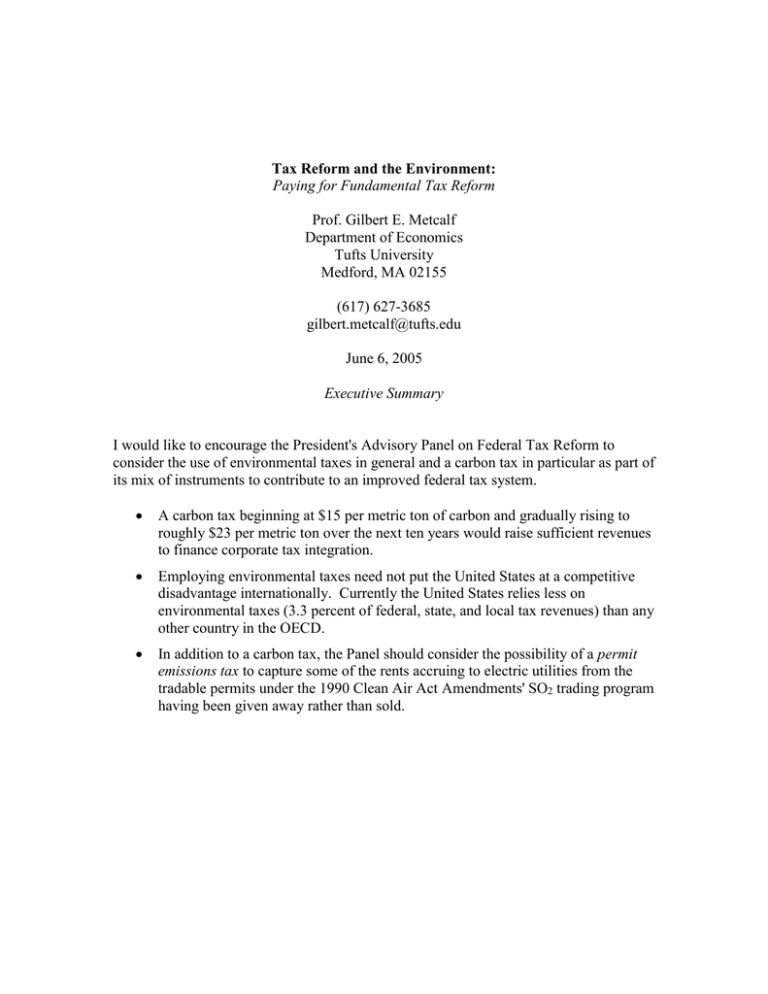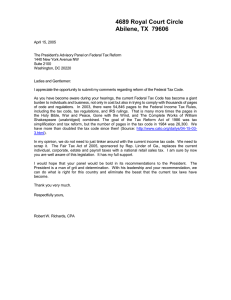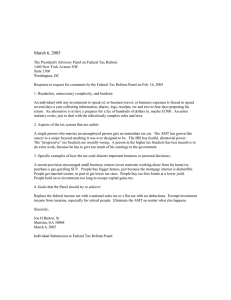Prof. Gilbert E. Metcalf Department of Economics Tufts University
advertisement

Tax Reform and the Environment: Paying for Fundamental Tax Reform Prof. Gilbert E. Metcalf Department of Economics Tufts University Medford, MA 02155 (617) 627-3685 gilbert.metcalf@tufts.edu June 6, 2005 Executive Summary I would like to encourage the President's Advisory Panel on Federal Tax Reform to consider the use of environmental taxes in general and a carbon tax in particular as part of its mix of instruments to contribute to an improved federal tax system. A carbon tax beginning at $15 per metric ton of carbon and gradually rising to roughly $23 per metric ton over the next ten years would raise sufficient revenues to finance corporate tax integration. Employing environmental taxes need not put the United States at a competitive disadvantage internationally. Currently the United States relies less on environmental taxes (3.3 percent of federal, state, and local tax revenues) than any other country in the OECD. In addition to a carbon tax, the Panel should consider the possibility of a permit emissions tax to capture some of the rents accruing to electric utilities from the tradable permits under the 1990 Clean Air Act Amendments' SO2 trading program having been given away rather than sold. Prof. Gilbert E. Metcalf Tufts University June 6, 2005 Tax Reform and the Environment With the exception of comments submitted by Duke Energy, it appears that no one has suggested how environmental taxes could help the Advisory Panel achieve its goals of simplification and greater rationality in the U.S. tax code. I have two points to make in these comments. First, the United States lags behind most other developed countries in its use of environmental taxes and charges as a component of its fiscal system. Second, our failure to avail ourselves of environmental taxes and charges means we are missing revenue opportunities which could help us tackle important fiscal issues in our federal budget. Environmental Charges: an Underutilized Resource The first point to make is that the United States collects little in the way of revenue from environmental charges (including taxes) and what little we do collect is collected in an inefficient manner.1 Even if we include taxes on motor fuels (which are – strictly speaking – not an environmental tax), environmental tax collections are trivial in the federal budget. Less than 4 percent of federal revenues came from excise taxes in 2004 roughly two-thirds of which could loosely be described as environmental in nature. How does the United States compare with other developed nations? Considering environmental taxes at all levels (federal, state, and local), environmental taxes in the United States comprised 3.3 percent of total tax revenues in 2001.2 By contrast, OECD countries as a whole collected 4.9 percent of taxes through environmental taxes. Germany's environmental tax share, for example, was 7.1 percent; the United Kingdom's 1 See Fullerton (1996) for an overview of environmental tax policy and the high costs of collection. Francis (1999) notes the decreased use of some environmental taxes in the 1990s. 2 The source for these and subsequent tax share numbers is the OECD Economic Instruments Database. 1 Prof. Gilbert E. Metcalf Tufts University June 6, 2005 was 7.5 percent; Denmark's was 10 percent. No country's environmental tax share in 2001 was lower than the United States' share. In short, the United States is at the very bottom of the distribution in terms of the fraction of government revenue collected through environmental taxes and charges and an increase in our reliance on environmental taxes should not put us at a competitive disadvantage relative to our trading partners in the OECD. Let me next turn to how we might use a green tax shift in the United States. Green Tax Shifts: Some Possibilities I'd like to discuss three examples of green tax shifts to illustrate how the Panel might use environmental tax revenues to help us achieve important fiscal policy goals. 1. Carbon tax to finance corporate tax integration A study that Kevin Hassett of the American Enterprise Institute and I did a few years ago explored instituting a carbon tax to finance corporate tax integration (Hassett and Metcalf (2001)). The idea of a carbon tax combined with a reduction in existing taxes has been extensively studied.3 The focus on a carbon tax is a natural one given rising concerns about global warming. Emissions of carbon dioxide (CO2) in 2002 totaled 1,581 million metric tons, according to the most recent report on greenhouse gas emissions from the Energy Information Administration (2004). A carbon tax is an obvious policy tool to help reduce carbon emissions. The Congressional Budget Office estimates that the ten year cost of reducing the double taxation of corporate income by excluding dividends and capital gains from taxation at the personal level is $266 billion. Based on CBO estimates, I calculate that a carbon tax starting at about $15 per metric ton 3 See, for example, Bovenberg and Goulder (1996) who consider cuts in the personal income tax financed by a carbon tax. 2 Prof. Gilbert E. Metcalf Tufts University June 6, 2005 and gradually rising to $23 per ton over a ten year period could finance this reform. The research that Hassett and I did indicates that such a reform would have little impact on the equity values of the affected industries and could in fact lead to increases in equity valuations for many industries. 2. Environmental taxes to help achieve distributional objectives The President's Advisory Panel on Federal Tax Reform is charged with thinking about ways to simplify tax collections and enhance efficiency in a revenue neutral context. The discussion above illustrates how environmental taxes could help us achieve considerable efficiency gains through capital income tax relief. My next example illustrates how environmental taxes can be used to achieve distributional objectives. A study I undertook a few years ago asked how we might carry out a revenue and distributionally neutral green tax reform. I hypothesized a green tax shift equal to ten percent of federal revenues in 1994.4 I modeled a new carbon tax, an increase in the motor fuels excise tax, new taxes on air pollution (or alternatively the federal sale of tradable permits giving firms the right to emit air pollution – as currently occurs under the SO2 trading system for electric utilities and as proposed under the Bush Administration's Clear Skies Initiative. Finally I modeled a tax on unrecovered waste, a so called virgin materials tax. The specific tax rates and amounts collected are not that important for our current consideration. Rather I'd like to emphasize that a common concern with environmental taxes is that they are regressive – that is they fall disproportionately on low-income individuals and households. My analysis confirmed this result when looking at the 4 This is an ambitious goal and would represent new environmental taxes of roughly $200 billion in the current fiscal year. I am reporting the research in Metcalf (1999) here. 3 Prof. Gilbert E. Metcalf Tufts University June 6, 2005 environmental taxes in isolation. I then modeled three tax reductions financed by the new (or increased) environmental taxes. First, I exempted from the OASDI payroll tax the first $5,000 of tax base for each worker (real $1996). Next, I implemented a refundable $150 tax credit for each exemption taken in the personal income tax. Finally, I modeled an across the board income tax cut of 4 percent. The net result was an essentially distributionally neutral green tax shift. The point of this exercise was not to make a case for this particular reform. Rather it was to emphasize the key point that while environmental taxes may be regressive, an environmental tax reform can have whatever degree of progressivity policy makers choose. Any regressivity in the environmental tax can be offset by progressivity in the tax reductions financed by the new revenues. The broader point in the context of the Advisory Panel's work on tax reform is that environmental taxes provide an additional instrument to help achieve whatever goals the panel has, whether they be related to efficiency, distribution, or some combination of the two. 3. Emission trading permit exercise tax As my last example of an environmental tax, I turn to cap and trade programs like the SO2 trading program for electric utilities implemented in the 1990 Clean Air Act Amendments or the various cap and trade programs such as proposed in the Clear Skies Initiative. Cap and trade programs such as the SO2 program have a number of attractive features as recently documented in the 2004 Economic Report of the President. How permits are allocated is an important issue in their design. The SO2 trading program grandfathered firms allocating permits to utilities on the basis of historic pollution levels. 4 Prof. Gilbert E. Metcalf Tufts University June 6, 2005 Grandfathering may make permit programs more palatable to affected industries but it means the government foregoes valuable revenue it could collect by selling permits to firms, revenue that comes without the deadweight loss generally associated with taxes. Economists have long argued that the government should sell rather than give away emissions permits in order to raise revenue to finance cuts in distortionary taxes. While this is good advice for future trading programs, it would be difficult to retroactively begin selling permits from the current SO2 trading system given the banking and forward purchase of permits that has occurred. The Panel could, however, propose a permit exercise tax. This would be a tax levied on any firm that used a permit under the current program in order to emit sulfur dioxide. In other words, this is a tax on the right to exercise the permit. In 2003 electric utilities emitted 10.6 million tons of SO2 emissions.5 A permit exercise tax of $250 per ton would raise $2.6 billion annually. Such a tax would capture a significant fraction of the economic rents generated by giving the permits to utilities in the first place. Conclusion Summing up, I strongly urge the Advisory Panel to consider adding environmental taxes in general and a carbon tax in particular to the list of tax reforms under consideration. These taxes would give greater flexibility to achieve important fiscal reforms elsewhere in the tax code while preserving revenue neutrality and contributing to a cleaner environment. I would be happy to provide additional information if the Panel wishes. 5 Burtraw, Evans, Krupnick, Palmer and Toth (2005) 5 Prof. Gilbert E. Metcalf Tufts University June 6, 2005 Bibliography Bovenberg, A. Lans and Goulder, Lawrence H. "Optimal Environmental Taxation in the Presence of Other Taxes: General Equilibrium Analyses." American Economic Review, 1996, 86, pp. 985-1000. Burtraw, Dallas; Evans, David A.; Krupnick, Alan; Palmer, Karen and Toth, Russell. "Economics of Pollution Trading for So2 and Nox," RFF Discussion Paper. Washington, DC: Resources for the Future, 2005. Energy Information Administration. "Annual Energy Review 2003," Washington, DC: Energy Information Administration, 2004. Francis, Brian. "Federal Excise Taxes, Including the Slow Death of Expired Taxes." Statistics of Income Bulletin, 1999, (Summer), pp. 185-89. Fullerton, Don. "Why Have Separate Environmental Taxes?," J. M. Poterba ed., Tax Policy and the Economy. Volume 10. Cambridge: MIT Press for the National Bureau of Economic Research, 1996, 33-70. Hassett, Kevin and Metcalf, Gilbert E. "Environmental Taxes to Finance Capital Tax Reform," Accurate Prices Program. Oakland, CA: Redefining Progress, 2001. Metcalf, Gilbert E. "A Distributional Analysis of Green Tax Reforms." National Tax Journal, 1999, 52(4), pp. 655-81. 6


![-----Original Message----- From: Frank [ ]](http://s2.studylib.net/store/data/015586880_1-cfb444a89eae26d4014d39539fbf7e46-300x300.png)